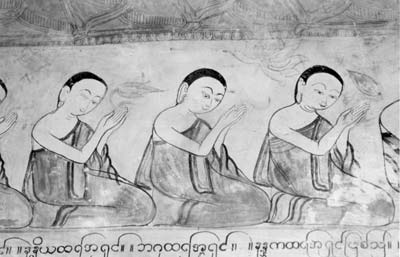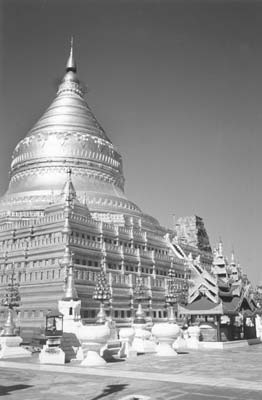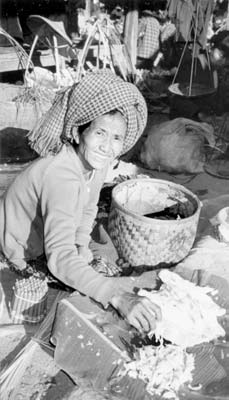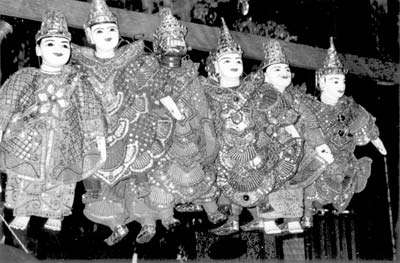Back to Bagan
by Julie Skurdenis
I am standing atop Bulethi Pagoda in Bagan, Burma’s most important archaeological site. I’ve huffed and puffed up a steep staircase to the uppermost platform encircling the structure. The platform is narrow — only three feet wide — and I lean back against the stone to steady myself as I gaze out over the plain far below me.
No exaggeration — I am surrounded by an archaeological sea of stone temples and pagodas, literally hundreds of them dotting the eastern shore of Burma’s greatest river, the Ayeyarwady (Irrawaddy). But even those I see spread out below me are only a small portion of the total number.
When I first visited Bagan three years ago, I was told that there were “about” 2,230 structures, but my guide, Win, informs me that this is no longer correct: “There are now many more because there has been lots of reconstruction in the past few years. There are even some new temples being built today.”
I’m impressed by the sheer number, but Win says that 700 years ago there were more than 13,000 temples and pagodas in Bagan, all built by a succession of 11 kings over a period of 230 years. I figure that’s an average of 57 new temples or pagodas per year.
Age of temple building
It was King Anawrahta who ushered in the age of temple building in Bagan in the middle of the 11th century. His successor, Kyanzittha, one of Bagan’s greatest rulers, continued the building throughout his reign (1084-1113). So did nine of his successors. All building ended with King Narathihapati (1255-1287) when Kublai Khan invaded. The Burmese themselves may have torn down or destroyed thousands of temples to build fortifications against the Mongols.
Before we began our intense 2-day plunge into seeing and/or visiting as many of the structures as we could, Win told us that it was important for us to know the difference between a temple and a pagoda. A temple — which the Burmese call pahto — is a building housing one or more images of Buddha. It is often several stories high, one terrace atop another, topped by a bell-shaped or corncob-shaped structure. A pagoda — which the Burmese call a zedi — is a solid structure housing relics of Buddha or of a revered monk.
Armed with this knowledge, we were ready to begin our exploration. But where to begin with over 2,300 temples and pagodas from which to choose? When I visited Bagan before, there were two I found particularly impressive: Ananda and Shwezigon. I wanted to revisit them.
Awesome Ananda
Ananda is considered among the most beautiful of Bagan’s temples. Completed by King Kyanzittha in 1091 in the early years of temple building at Bagan, it was supposedly designed to resemble the Himalayas. From a distance, with its multiple terraces, towering gold spire, or sikhara, and numerous pagodas at the terrace corners, it does.
Inside, Ananda has four 30-foot-high Buddhas facing outward toward the four cardinal points. Hundreds of miniature Buddhas fill niches lining the walls. Outside, glazed terra-cotta tiles along the base of the terraces illustrate Jataka tales, stories from the lives of previous Buddhas. Alongside them are fierce-looking squattish stone lion-dragons, “broad in the beam,” as my husband, Paul, says.
Ananda is a pahto. Shwezigon is a zedi. Begun by Anawrahta, Shwezigon was completed by Kyanzittha in 1089, just two years before Ananda. It is said to enshrine a replica of Buddha’s tooth.
A corridor lined with stalls (where wonderful, inexpensive wood carvings and gilded Buddhas are sold) leads to the terrace on which the enormous gilded bell-shape zedi rests, crowned by an umbrella-like structure called a hti. Smaller zedis rest on the upper terrace’s corners. The 13-foot-high Buddhas on each of the four sides of the central zedi were cast in 1102 and are reputedly Bagan’s largest surviving bronze Buddhas.
Other Bagan highlights — Gawdawpalin with enormous golden seated Buddhas; Sulamani with beautifully carved doorways and frescoes depicting ships and sea creatures; sunset from Izagawna; Mingalazedi with hundreds of blue glazed tiles covering its terraces; Kyanzittha Cave with vividly colored murals depicting processions and elephants plus worshipers praying before Buddha images, and sunset from high atop steep Shwesandaw.
Beyond Bagan
Anyone visiting Burma (Myanmar) will almost certainly be coming from Myanmar’s capital, Yangon, once called Rangoon. If a visitor sees only one sight in Yangon, it should be Shwedagon Pagoda, considered the most sacred Buddhist site in Burma. It is a spectacular complex — four long staircases lead upward to a large platform. On this rests the golden zedi surrounded by dozens of statues, shrines, prayer halls, bell pavilions and temples.
Hundreds of pilgrims circle the zedi clockwise, stopping to offer flowers or pour water over the animal associated with the day of their birth. I pause at the east side of the zedi to pour water over the tiger, associated with Monday, the day on which I was born.
To miss seeing Shwedagon is to miss the icing on the Burmese cake.
It would have been worth traveling to Burma just to spend a day in Bagan and a few hours at Shwedagon, but this trip offered so many more sightseeing riches and unique experiences in addition to these two outstanding places.
Among the many highlights of our 11-day trip were examining the wonderfully detailed woodcarvings at Shwenandaw Monastery in Mandalay; shopping for exquisite puppets at Scotts Market in Yangon; visiting the monks who line up with black glazed bowls for their mid-morning meal at Maha Aungmye Monastery in Mandalay; wandering among the gilded Buddha images in Pindaya Cave on the way to Inle Lake; having afternoon tea at the deluxe colonial-era Strand Hotel in Yangon, and having our fortunes told by an astrologer at Kyauktawgyi Paya in Mandalay.
Inle Lake is so special a place that we wished we had more than just an overnight there. But in our two days we visited several of the colorful local markets; saw dozens of leg rowers skim across the surface of the lake; watched the cats jump through hoops at Nga Phe Kyaung Monastery, popularly called the Jumping Cat Monastery; photographed Padaung women who wear heavy circlets of brass hoops around their necks, and sailed past villages where the houses are built on stilts in the middle of the lake.
If you go. . .
My 11-day trip to Burma/Myanmar in January 2003 was with Bestway Tours & Safaris, a superb company I had traveled with twice before (North Africa and Iran). Bestway, which celebrated its 25th anniversary in 2003, specializes in small-group travel and offers travel experiences worldwide, including to such destinations as Vietnam, Peru, Central Asia and even Afghanistan. I combined a 2-week trip to Vietnam with this trip to Burma.
My trip, “Fascinating Myanmar,” cost $1,220 per person and included tours, transportation, accommodations, breakfasts, admissions and flights within Burma. It did not include international airfare or other meals. This trip is offered twice a month throughout the year.
In Bagan we stayed at the very special Bagan Golf Resort, located close to the archaeological zone, in a beautiful brick bungalow beside the pool. Unlike so many cookie-cutter hotels, the Bagan Golf Resort gives its visitors a “sense of place” in its decor. Other hotels used by Bestway in Burma were of similar quality.
Bestway is located in Vancouver, Canada; phone 800/663-0844, e-mail bestway@bestway.com or visit www.bestway.com.
Lonely Planet publishes an excellent guidebook to Burma.
Someplace special
From New York, we flew to Singapore and then on to Yangon, Burma. My rule of thumb for Singapore is when in Singapore, eat at Raffles, drink at Raffles, shop at Raffles and, if possible, sleep at Raffles. We did all four in the three nights we spent in Singapore on our way back from Burma.
Raffles is special. It’s on my list of 10 favorite hotels around the world. It’s expensive (room rates start at $365) but worth every cent. On this trip, we stayed in the Somerset Maugham Room, an understatedly elegant room off the Palm Court, complete with some of Maugham’s books to browse through.
If you can’t sleep at Raffles, then eat there. There are 19 restaurants, cafés and bars. Our favorites are the Tiffin Room for Indian buffets, the Empress for Chinese cuisine and Ah Teng’s Bakery for pastries and cappuccino. For drinking, there’s the famous Long Bar, where the ambiance is dark and shuttered with fans revolving overhead and peanut shells underfoot. The drink of choice is, of course, the Singapore Sling, which was invented there.
There’s no better place to decelerate from a fast-paced trip than Raffles; e-mail raffles@raffles.com or visit www.raffles.com.
Julie Skurdenis received a partial discount from Bestway Tours & Safaris and from Raffles.






